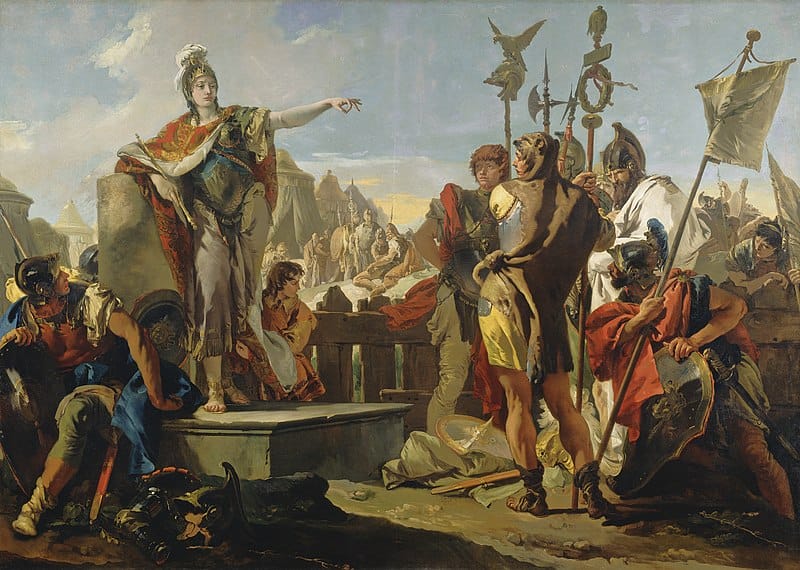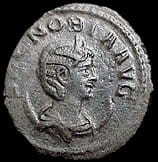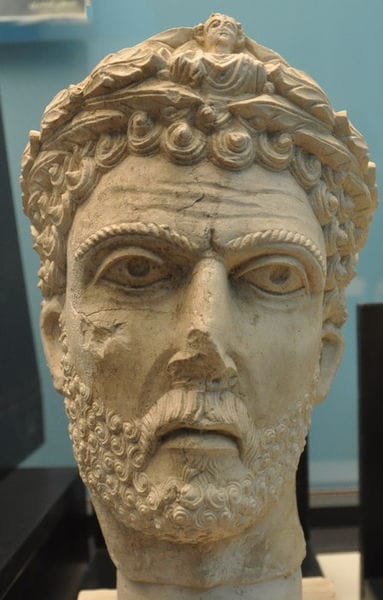The tale of Queen Zenobia is one of resilience and ambition. As the ruler of Palmyra, an oasis city in the Syrian desert, she governed over a diverse and prosperous domain. Her reign, which began as a regency for her young son after the death of her husband, the king, soon took on a legendary character. She exhibited extraordinary political acumen, expanding Palmyra’s territories and influence during a time of Roman struggles with internal chaos and external threats.

Her boldness is most famously captured in her defiance against Rome, which signaled a break from Palmyran’s subordination to Roman authority. Zenobia’s ambitions led to the expansion of her domain into Roman territories but eventually precipitated a conflict with the ancient world’s major superpower, leading to her capture. Despite her defeat, Zenobia remains a powerful figure in history because of her role in challenging an empire and for the cultural and economic achievements of her city under her rule. Zenobia’s legacy endures as a symbol of female leadership and as a critical figure in the narrative of Middle Eastern antiquity.
Key Takeaways
- Zenobia emerged as a key ruler in Palmyra, showcasing remarkable leadership and ambition.
- The expansion of Palmyra’s influence under her reign led to a direct conflict with Roman authority.
- Zenobia’s legacy persists as an emblem of powerful female rule and cultural accomplishment in ancient history.
Early Life and Rise to Power
Zenobia, known in Latin as Septimia Zenobia, emerged as a prominent figure in the 3rd century, particularly within the realm of Syria. Her grasp of both Greek and Latin languages, along with her eventual titles as queen and regent, shaped her legacy.
Marriage to Odaenathus
Her journey to power began through her marriage to Odaenathus, the King of Kings in Palmyra. This union positioned her as a key figure in Palmyrene society, where she demonstrated her capability in both domestic and political spheres.
Ascension as Regent for Vaballathus
Following Odaenathus’ death, she became regent for their young son, Vaballathus. Her regency was characterized by the strategic assertion of power as she navigated the complex relationship with Rome while asserting her son’s authority. The regal titles of ‘Augusta’ for herself and ‘King of Kings’ for Vaballathus were emblematic of their sovereignty and the political acumen with which Zenobia operated.

Zenobia’s Reign
Zenobia’s ascension to power marked the beginning of a notable period in the history of the Palmyrene Empire. Under her reign, the empire expanded significantly and became a center of cultural and economic development.
Expansion of the Palmyrene Empire
Zenobia, the renowned Queen of Palmyra, was ambitious in her military endeavors, quickly extending her influence over Syria and parts of Egypt. Her armies were successful in asserting Palmyrene power, challenging the dominion of Rome over these regions. The expansion not only demonstrated her remarkable military strategic abilities but also echoed the empire’s quest for resource control and trade dominance.
Economic and Cultural Developments
During her reign, she fostered a flourishing multicultural society where several languages and cultures intertwined. Palmyra became a vibrant hub for trade and learning, and this fusion is speculated to have been represented on Zenobia’s coinage, implying her legitimacy and authority. Moreover, economic prosperity under Zenobia was bolstered through thriving trade networks that connected the East and West, making the empire a significant cultural and economic crossroad of the ancient world.
Conflict with Rome
Her ambitious expansion of the Palmyrene Empire precipitated a critical conflict with the Roman Empire, ultimately leading to her defeat and the empire’s fall. The struggle with Rome highlighted her remarkable leadership but sealed the fate of her realm.
The Fall of the Palmyrene Empire
After declaring her son emperor and expanding her rule over Egypt’s grain resources, her actions were perceived as a rebellion against Rome. In response, Roman Emperor Aurelian decided to act decisively to reassert control over the breakaway empire.
Roman armies were dispatched, and the conflict quickly escalated. Aurelian’s forces managed to recapture territories that Zenobia claimed, subsequently besieging Palmyra. Despite her resilience and the strength of Palmyrene forces, she was eventually captured by the Romans. The siege of Palmyra was marked by the display of traditional Roman military discipline and tactical acumen against Palmyrene resistance.
Following her capture, Zenobia and her son were taken to Rome. Although there was an initial refusal, the Palmyrene queen was eventually compelled to surrender. The war concluded with the Roman Emperor solidifying his power and the Palmyrene Empire being reabsorbed into the Roman Empire. This conflict underscored the might of Rome and the peril of usurping the authority of the Roman Emperor.
Legacy of Zenobia
The legacy of Zenobia, queen of the Palmyrene Empire, endures through her depiction as a fusion of political authority and cultural significance, an image that has been shaped by historians and preserved in various forms of art and culture.
Portrayal in Ancient and Modern Culture
She is frequently compared with Cleopatra in her combination of beauty and leadership. Recognized for her multilingual abilities, she was fluent in Aramaic, Greek, and Latin, a testament to her embrace of learning and cultural diversity. Zenobia’s image appears on ancient coins, which both reinforces her status as an icon of authority and serves as a symbol of her enduring legacy.

Source: Classical Numismatic Group, Inc. https://www.cngcoins.com, CC BY-SA 3.0 https://creativecommons.org/licenses/by-sa/3.0/, via Wikimedia Commons
In modern times, her story continues to captivate. Historians debate her role and influence, often casting her as a symbol of female empowerment. Her portrayal in contemporary art and culture reflects a fascination with her life – a blend of fact and folklore that traverses time. Depictions in literature and media often emphasize her strength and learning, inspiring new generations with her commanding presence.
Historical Context and Impact
Dynastic Influence and Succession
After her husband’s death, she quickly orchestrated the ascent of Palmyra from local power to a regional empire, asserting control over parts of Asia Minor and Egypt. This expansion challenged the authority of the Roman Empire, with whom Palmyra had maintained a client-state relationship.
Her rule is characterized by a unique blend of cultures, bringing together the Palmyrene, Roman, and Semitic traditions. Zenobia claimed descent from Cleopatra, suggesting an association with the Ptolemaic Dynasty of Egypt, further solidifying her link to previous powerful rulers and her own legitimacy. Diplomatically astute, she fostered positive relations with influential Roman politicians and built strong trade networks – capitalizing on Palmyra’s strategic location near the Euphrates, which was crucial for commerce between the Roman territories and eastern civilizations like Persia.

Militarily, Zenobia demonstrated remarkable acumen, bolstering her armies and challenging Rome’s dominion. Her forces successfully annexed territories in Egypt and the Levant, briefly establishing the Palmyrene Empire as the dominant power in the east of Rome.
Zenobia’s reign eventually prompted a Roman response, leading to conflict with Emperor Aurelian. Although her armies initially secured victories, ultimately, Aurelian’s forces prevailed. After her defeat, Zenobia was taken to Rome, where her fate remains somewhat mysterious, as accounts of her death vary among historical records.
Historians often debate Zenobia’s motives and legacy, considering whether they had sprung from personal ambitions, a desire to maintain Palmyra’s prosperity and autonomy, or broader goals of securing a sovereign Palmyrene Empire. Her influence has been acknowledged in various cultural depictions and studies, contributing to the understanding of female leadership in the ancient world.
People Also Ask:
What historical significance does Zenobia hold in ancient history?
Zenobia was a prominent figure in the Third Century, known for her ambitious attempt to expand the Palmyrene Empire and challenge the Roman Empire’s dominance. Her reign marks a significant period of upheaval and change in the ancient world, as detailed in discussions about her political alliances in third-century Syria.
How did Zenobia become the queen of the Palmyrene Empire?
Zenobia became queen after the death of her husband, Odaenathus, the king of Palmyra. She then acted as regent for her young son before effectively taking control of the empire, demonstrating her strategic brilliance and leadership ability.
What are the notable facts about the archaeological site associated with Zenobia?
The ancient city of Palmyra is an archaeological site that was once the thriving center of the Palmyrene Empire under Zenobia’s rule. This site contains invaluable ruins that offer insights into the rich cultural and architectural history of her reign.
What can divers expect to see when exploring the Zenobia shipwreck?
Divers exploring the Zenobia shipwreck off the coast of Cyprus will encounter a large commercial ferry that sank on its maiden voyage in 1980. It’s now a popular diving destination renowned for its spectacular marine life and the well-preserved state of the wreck.
How is Zenobia represented in religious texts?
Zenobia’s story shares common motifs with various religious and historical texts, including the Jewish tale of Judith. These texts reflect her reputed wisdom and bravery and exhibit her influence on the storytelling traditions of different cultures.
In what ways has the legacy of Queen Zenobia impacted modern culture?
Queen Zenobia’s legacy has persisted into modern culture, often emblematic of a strong and intellectual female leader. Creators continue to find inspiration in her story, reflected in various forms of literature and media that highlight her remarkable life and accomplishments.
Hello, my name is Vladimir, and I am a part of the Roman-empire writing team.
I am a historian, and history is an integral part of my life.
To be honest, while I was in school, I didn’t like history so how did I end up studying it? Well, for that, I have to thank history-based strategy PC games. Thank you so much, Europa Universalis IV, and thank you, Medieval Total War.
Since games made me fall in love with history, I completed bachelor studies at Filozofski Fakultet Niš, a part of the University of Niš. My bachelor’s thesis was about Julis Caesar. Soon, I completed my master’s studies at the same university.
For years now, I have been working as a teacher in a local elementary school, but my passion for writing isn’t fulfilled, so I decided to pursue that ambition online. There were a few gigs, but most of them were not history-related.
Then I stumbled upon roman-empire.com, and now I am a part of something bigger. No, I am not a part of the ancient Roman Empire but of a creative writing team where I have the freedom to write about whatever I want. Yes, even about Star Wars. Stay tuned for that.
Anyway, I am better at writing about Rome than writing about me. But if you would like to contact me for any reason, you can do it at contact@roman-empire.net. Except for negative reviews, of course. 😀
Kind regards,
Vladimir
